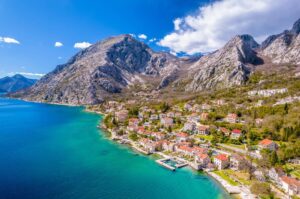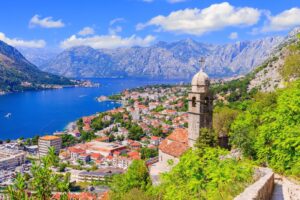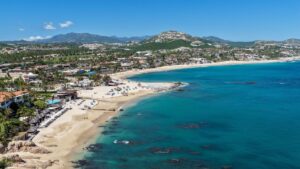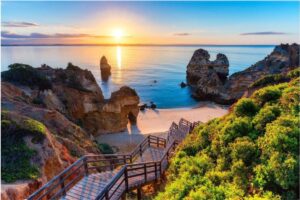Everything is modern, new, and shiny.
The Malaga airport is state of the art. New highways propel drivers west to Marbella, on to Gibraltar and toward Portugal. The new high-speed rail line is designed to take you to Cordoba, Madrid and beyond at speeds of up to 186 miles per hour.
Brits, Germans and Scandinavians flood on and off flights; 12.8 million passengers landed here on direct flights from 60 countries last year. Budget airlines will fly you here and back to Northern Europe for $100 or less. Flight times are two to three and a half hours. This is convenient like Florida is to a New Yorker.
The visitors I’m watching are desperate for some spring sunshine. Cheap beer…or fine dining. Some (mostly Scandinavian or Russian) are even here to pick up real estate on the cheap. The local English language tabloid uses almost every column inch of its cover page to tell us that foreign buyers are back.
There are deals to be done.
Bank-foreclosed condos sell at discounts of up to 67% from prices four years ago. Up to 107% finance is available (more about how this works later). That’s enough to cover your closings costs.
Plus, the entry price point can be manageable.
Like $135,000 (U.S. dollar prices are based on an exchange rate of 1 eur : $1.30) for a two-bedroom, two-bath condo that was put on the market four years ago for $380,000. This condo is in La Duquessa…22 minutes from the high-end Porto Banus where you’ll find the luxury shops and traffic jams of Bentley and Ferraris. Up to 70% finance is available on this condo.
Down the coast $140,000 buys you a 4-year-old, never been lived in, two-bedroom, two- bath condo direct from the bank. This buys you 900 square feet of inside space and a terrace of up to 600 square feet on the ground floor. A marina is an eight-minute stroll away; Malaga airport is 50 minutes away. This condo stays rented in July and August for $725 per week.
Why I’m Here (and Why Now)
The primary focus of my trip, though, isn’t the Costa del Sol. (I’ve never been drawn to the Costa del Sol. However, some of my perceptions are being challenged on this trip.) It’s here in the ancient city of Granada.
The March sun is warm on my face. (I took this scouting trip back in March. I’m only filing my preliminary report now as my visit required follow-up research; research that continues.) The snow-covered Sierra Nevada mountains tower above us and glint in the sunshine. Sunglasses are a must. When I left Marbella on Spain’s Costa del Sol 90 minutes away on a modern highway, it was a balmy 75 degrees. I haven’t seen a cloud since I arrived.
Here in Granada’s historic center, and at 2,200 feet above sea level, it’s 63 degrees. In the bright sunshine, it feels much warmer. I’m comfortable in short sleeves.
Bright blooming flowers line the streets and crawl up historic buildings. Cured meats hang from the ceiling of the taverna where I have stopped for lunch. The lady of the taverna slices serano ham and manchego cheese while we eat the tapas of deep fried potato and onion she greeted us with. The bocadillo (bread roll) is lightly toasted before being topped with ham and cheese and a drizzle of olive oil. Yum. She insists that we wash it down with Lico de Hierbas (liqueur of herbs). This is historic Spain. I like it.
The beautiful and glamorous are all around. Some rest skis on their shoulder. Others sip cava in the sunshine, head stuck in a book. Others take in the historic sights on walking tours. I see mostly Spaniards…and some northern Europeans. Many come from Madrid for a weekend retreat. It’s very different to the Costa del Sol where British and Germans come to drink the same beer they do at home and eat the same food. I like it here…where it’s authentic.
Home to three UNESCO world heritage sites (the Alhambra, Generalife and Albayzin), Granada is steeped in history and attracts visitors from across the world. Its international airport has flights from most major European cities, and it’s within a two-hour flight range of Northern Europe’s major population centers.
Culture, beaches, world-class golf and other outdoor activities are easily accessible. This area appeals to weekend-break visitors, golfers, history buffs, and even as a wedding destination.
Domestic visitors and North Americans come in large numbers. And, of course, it’s a beautiful place to retire.
I have found a newly-built, modern 800-square-foot condo that’s seven minutes from the heart of Granada, for under $100,000. Up to 95% finance is available directly from the bank that has foreclosed on these units.
What Went Wrong in Spain
This is an exciting find. But, we need to step back and digest Spain’s macro-picture. Here’s what happened over the past couple of decades:
– Home ownership in Spain (now over 80%) is encouraged through policy and a range of tax breaks. Municipalities were encouraged through windfall payments to designate land for development.
– Cheap money floods Spain even as its economy overheats. Remember: interest rates in the Eurozone are set at the ECB in Frankfurt. Both Ireland and Spain were on a tear in the 1990s when Germany was still recovering from reunification. Cheap money flooded overheating economies. Spain suffered serious erosion of its competitiveness. Salaries were, and stayed extremely low in Spain. They didn’t rise in line with real estate prices. The price of a median home peaked at 13 times the median household income.
– Meantime, it seemed like every Brit and Irishman couldn’t show his face in the pub if he didn’t have his own little piece of Spanish costa. Many buyers bought with little or no money down. Some were buying purely to flip. It’s very important to understand that mortgage debt is Spain IS NOT non-recourse. Nor is recourse limited to assets in Spain. Spanish banks are now looking to seize buyers’ homes in the UK, for example, to make up holes in underwater mortgages.
– Mid-2007 the music stopped. In the year to mid-2008, sales volume fell by over 40% in places. The financial crisis of 2008 was the final nail in the coffin.
– Today, half of Spain’s young are unemployed if they haven’t already emigrated. Unemployment runs at 24%. Spain has a very active (and growing) shadow economy.
Many of these unemployed do okay, supplementing relatively generous benefits with side work. Wages are extremely low in Spain. Wages are quoted net…what the employee actually gets after all taxes and social security are deducted. Most young people take home a little more or a little less than $1,300 per month. That’s barely above the minimum wage. But, more people-and more highly skilled people- work for the minimum wage in Spain than you will find in places with a tighter labor market.
In my hotel the receptionist was charming, capable and hard working. On top of her native Spanish she spoke fluent English and German. Her French was good enough to get by with guests. I asked one of my contacts how much she would make…$1,300 a month. This is extremely important to understand when it comes to analyzing the rental market in Spain. You don’t have much scope to command high rents from the market.
– Estimates put the total of Spain’s excess supply and distressed inventory as high as 2 million units. Much of this inventory (50% is a reasonable guess) is along the touristy costas.
– There has been almost no effort to sell this massive inventory. The banks have been hoarding inventory. They don’t want sales. Sales will crystalize losses and force write-downs.
– The Spanish government forced banks to increase their write-downs of bad real estate loans. Few, if any believed that Spanish banks were accurately reflecting the scale of bad real estate loans. This drove borrowing costs higher and share prices lower. The revised figures still aren’t credible. But, the increase in write-downs has helped encourage banks to get realistic and the pricing at which they dispose of distressed inventory.
Spain agreed to accept assistance from European partners to re-capitalize their banks. Up to 100 billion euros have been offered. As I write it’s unclear how much Spain will draw down.
Spain has a rough road ahead. The fire sales are only getting started.
Sitting here, in a grand Plaza looking up at the towering Sierra Nevadas and across this ancient city with the fragrant smell of flowers drifting in the air, things don’t feel too bad. I have seen no riots, demonstrations, or even one beggar.
This is still a wonderful place to spend time. Now we can do it for cents on the euro.
Spain is a diverse country, geographically, culturally, economically and even linguistically. In Andalusia and Granada for example you will be struck by the Moorish influences. The music, folk songs and some of the countryside of the Basque country could be Ireland or Scotland. In and around Barcelona, the people are fiercely defensive of their Catalan language. And the crisis is affecting different places in different ways.
Granada escaped the major development seen on Spain’s costas and in her major cities. This means that development has been tasteful, and there isn’t the major oversupply problem that we see on many of the costas. This part of Spain has intrinsic value that will always hold appeal.
I’ve been following the market here for the past three years. I haven’t seen a deal I liked here since late 2009 when introduced members of our group to a distressed opportunity. The deals just haven’t been good enough to get my attention. Because Granada didn’t see the development we saw in other parts of Spain this also means that distressed completed condos in the right part of town are almost non-existent.
I touch base with my contacts on the ground every couple of months. To shoot the breeze about what’s happening, and what might be coming down the track.
The First Spanish Deal in 3 Years to Get My Attention
The week before this trip a banking contact called me with an opportunity that grabbed my attention. Newly completed condos in an historic area minutes from Granada’s historic center. A bank has foreclosed on the developer. Prices start from under $100,000 and up to 95% financing is available. Five minutes later my flight was booked.
The area where these condos are located is peaceful, quiet, and classy. It’s surrounded by high-end villas with pools. Except for this building it’s all high-end single family homes. The area is known as “Little Vatican” because of the churches and convents dotted around the neighborhood. Granada’s historic center is seven minutes away.
Construction of the condos is complete; and to a very high standard. When scouting for distressed opportunities I’m only interested in construction that is complete, and, that the HOA is functioning. And I’m looking for somewhere where there isn’t a supply overhang. This is a stunningly beautiful place that ticks these boxes.
And, with prices for an 800 square-foot condo starting at less than $100,000, this is a killer deal. Of course real estate here is priced in euros. So, you have a currency risk. Who knows what the future holds for the euro. But, your mortgage of up to 95% is also in euros. So by mortgaging your property you hedge most of your currency risk. Your monthly payments could be as low as $600.
The bank that has foreclosed on the developer is offering this finance deal…even to Americans and Canadians. Put simply: They are trying to turn a non-performing loan to the developer into many smaller performing loans to people like you.
These condos were built with the local market in mind. Young professionals or retirees from the area looking to downsize would live here. Or so the plan went until the crisis hit. The developer did a good job finishing the building but couldn’t pay the bank back. So, they took back the condos and wanted to pass them on to someone who will be able to make monthly payments starting at $600 for a mortgage.
Construction costs alone would have been in excess of $200 per square foot. And that’s not figuring any site cost. You can buy from $125 per foot.
In Spain, like much of Europe, transfer costs are high. It can vary, but figure on 10%. But, your holding costs are low. Your monthly holding costs of one of these condos break down as follows:
HOA fees: $25 per month.
Property Tax: $250 per year.
Trash/Water: $30-$35 per month depending on water consumption.
These condos would rent long-term for about $500 per month. There isn’t a short-term rental market in this area. No one’s doing it. This surprised me. We are seven minutes from Granada’s historic sites and 22 minutes from the ski slopes in a leafy luxurious setting. If someone was willing to market and work at it, I think they could build a short-term rental client-base. Maybe a group of owners could club together for marketing.
This is a strong opportunity if this is a place you want to visit, spend time in, and use. And: if you are willing to ride out whatever turbulence the immediate and medium terms have in store for Spain. Remember: the demand from northern Europeans for winter sun isn’t going away. If you go a block off the main tourist drag, eating, drinking, and shopping in Spain is affordable by any standards. Fly in from Norway and it’s almost free!
I expect to see further downward pressure on prices across Spain. But, deals like this don’t come up often in Granada. Boots-on-the-ground research there show me that there is very little of it being hoarded by the banks—there hasn’t been the over-building we have seen in other parts.
I visited this project with real estate group, Always Marbella. You can email them directly here: info@alwaysmarbella.com. As you can gather from their name they are also active on the coast. Let them know what you are looking for and they will direct you to the best person to deal with your inquiry.
As I said, my research on Spain is ongoing. In particular I’m carrying out due diligence on the small print of these mortgage offers on distressed inventory, other local considerations like regional permitting and regulations around rentals.
But, I wanted to make sure you had the opportunity to get in on this once you have done your due diligence. I just don’t know if/when something like this will come up in Granada again—irrespective of how sour things turn in Spain.
Important Tips When Buying in Spain
Finally…some tips for buying in Spain.
– Always take and follow reputable independent legal advice. This goes without saying everywhere. Remember, in the boom times there was a lot of unpermitted construction in Spain. Corrupt officials were paid off to look the other way. In a nightmare scenario you could buy something that has a demolition order attached to it. Don’t believe the seller that all is in order. Suck up the legal fee and sleep at night.
– Buyer beware. In the boom times Spain attracted a horrible breed of transient snake oil- type real estate salesmen. They would sell their mother for a quick commission. Thankfully, most of them are gone to sell time shares in Dubai or cars to soldiers in Iraq. But some are still floating around. The bad projects still pay big commissions. That’s where these guys will bring you. The killer bank foreclosure deals pay tiny commissions. Reputable agents will sometimes charge a buyer’s fee to compensate for tiny bank commissions. Look at your total deal cost. What you are getting all-in. If you are saving $50,000 by buying a bank foreclosure in a great location don’t get upset about cutting your agent and check for $3,000.
– Some banks offer 107% financing on distressed inventory. Great if you are looking for this leverage, but make sure the price is right. You don’t want to overpay. Some of the deals that I have looked at where 100% plus finance was offered were at grossly inflated prices. Banks were still asking up to 30% more than what I considered to be market price. You could end up with a 130% mortgage and be underwater the day you sign. And remember: they have recourse and can chase your assets. Never overpay despite how attractive the finance terms are.
– Always, irrespective of the type of distress play you are making, you need to follow our golden rules for buying distressed property:
#1. Buyquality (location, construction, amenities, and fit-out). In the boom years, junk was built that should have never been built. Avoid these junk deals, regardless of how attractive the sticker price looks.
#2. Don’t take on any construction risks, buy completed units. You don’t want to rely on a developer’s promise that he will complete the units. He may fail and never deliver.
#3. Don’t take on any project risk…make sure if you buy into a condominium project that it is functioning. You don’t want to be one of only 10 owners in a 100-unit condominium. If the community fails, no matter how nice your unit is, it could well be worthless.
We have a big opportunity in Spain. It’s set to get bigger.
Stay tuned.
Wishing you good real estate investing,
Ronan McMahon










